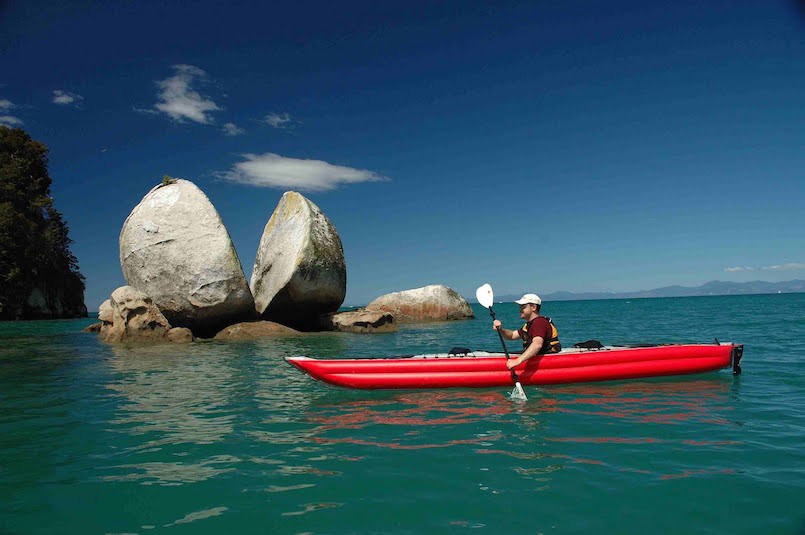Gear
Choose the Right Portable, Rigid, Folding or Inflatable Kayak

It’s tough choosing a kayak especially your first kayak and there are a lot of questions that need to be explored and answered like: What is the right style or design for you? Pricing out what you can really afford? What type of kayaking are you going to be doing most of the time? The intent of this article is to help you make a good choice based on your research while you are shopping for your kayak. Here are a few guide lines and tips to follow, so let’s get started….
First you need to know all the basic construction categories you will run into. There are basically three types of kayak structural classifications:
1. Hard Shell or Rigid kayaks, which can be made up of either:
- plastic
- fiberglass
- Kevlar
- carbon fiber
- Wood
2. Folding kayaks.
3. Inflatable kayaks.
The rigid (hard shell) kayak is what most people think of when they hear the word kayak. Of the various Hard Shell models, a plastic kayak is usually the least expensive but also can be the heaviest. They are usually tough and can take the abuse, but if they get damaged, they are very difficult to repair if at all.
A fiberglass Kayak will be a much more expensive model than a plastic model, but is significantly lighter. Fiberglass can be easier to damage, but can also be easier to repair (can be expensive) compare to the plastic version.
Composite types such as Kevlar, graphite and carbon fiber kayaks will be even more expensive and lighter still and more costly to repair once damaged then the other two mentioned already.
Wooden kayaks are the original and hand-made quality model. A smooth, warm wood kayak can be a beautiful thing. The prices on wood boats vary considerably. They are easy to repair but do require lots of routine maintenance like an ordinary boat would. Need to be stored properly and the quality can vary as well – depending on the craftsmanship.
Folding kayaks offer the advantage of easy portability and storage. A folding kayak is a collapsible – made of fabric stretched over usually an aluminum frame – but that can vary. Their price is on the expensive side when comparing kayak prices, but they tend to last longer than a typical hard-shell and their resale price usually remains reasonable (depends on the care it received over the years).
They are tough, flexible, stable and seaworthy, but the general consensus is that they lack a bit of the speed and performance vs. a hard-shell. Like wooden kayaks, folding kayaks bring a sense of the past North American native culture to them.
Now Inflatable kayaks offer the best portability of all the models and ease of storage.
They can be the least expensive kayaking option – especially when you consider all the options like storage, portability and maintainability. Thousands of people have been using inflatable kayaks for years and have grown to appreciate how easy they are to get them into the water and back out. After it dries off, how easy it is to store them in your boat carry storage bag which then can be put in either the trunk of your car or once home in a storage closet. Inflatable Kayaks have come a long way and are very sturdy and safe to us. Both US Coast Guard and various rescue crews have used inflatable boats and kayaks for years.
But, as important as the structural makeup of the kayak is, kayaks are typically classified to the type of kayaking they’re designed to do. Kayaks built for touring are much different from those for whitewater paddling. There isn’t any single kayak that will excel in every type of paddling category. As you shop for your kayak, you need to anticipate your future paddling style and then select a kayak that should perform well in that primary kayak category but also keep in mind your skill level and price range as well. Now there are kayaks out there – especially in the inflatable kayak category that lends itself better to multiple styles/designs then their counter parts. So if you are not sure if you will be using your kayak in any one particular category, consider some high quality companies like Sea Eagle, Innova, Airis and Advance Elements to name a few who use a lot of cross over inflatable kayaks to fit multiple needs. But keep in mind that they will not excel in all categories, they still focus on one particular category but do well in other categories better then most. So focus still on a particular category.
What kind of kayaking will you be doing?
You want to get a kayak that is well-suited for the type of kayaking you plan on doing most of the time. This is one of the most important factors you’ll need to consider; to determine what kind of paddling you will be doing and how often you will be doing it – White-Water (how advance), Touring, fishing, only ocean kayaking or just casual kayaking. There will be times you will try to do all three but just be cautious – especially if you start out with casual kayaking and then decide to go to Category IV Whitewater kayaking – make sure your kayak can handle Advance Whitewater kayaking. If you are a beginner or your skill level is not where you want it to be perhaps start out with a kayak that is geared to a more causal kayaking style/design with perhaps the rating to handle a mild to moderate whitewater level so as your skill levels improve you have a kayak that will get you to that level. When you get to the more seasoned pro level then trade it in for a kayak that can handle some serious white water rapids.
Your experience as a kayaker Counts
An experienced kayaker when shopping for their kayak, will most likely look for different qualities in a boat than a beginner kayaker would. An experienced person will usually look for what they call a kayak with good final stability, while the beginner will more or less value good initial stability – less tipsiness. The tipsiness that is normal for all kayaks with low initial stability makes beginners uncomfortable and shy away, but it is this tipsiness that generally indicates a kayak has greater final stability, something advanced kayakers value when they’re handling bigger waves. [Further clarification on stability: Initial stability is the tendency of the kayak to lean or shift away from an upright position. Final stability is the tendency of the boat to actually tip over. A boat with good final stability that seems tippy will be more forgiving by staying in a leaning position instead of tipping over. A boat can’t have both good initial stability and good final stability – it’s pretty much one or the other. The hull shape will determine what kind of stability the boat has. Another issue with stability is its comparison to speed. A highly stable kayak will usually not be the faster kayak on the water. Typically, the stable kayak will be wider and slower than the narrower faster kayak].
An experienced kayaker more or less prefer a tighter cockpit, while a beginner will usually prefer a larger one making it easier to get in and out of the kayak. Still other beginners may be concerned about either escaping from a tipped-over kayak or being forced to successfully perform what is referred to as an Eskimo roll in order to get back above the surface. If this is a concern, then perhaps a sit-on-top model with a recessed seat and foot-wells may be a great choice or perhaps going with an inflatable kayak which have multiple air chambers for redundancy which results in greater stability than rigid kayaks. With more stability, unlike rigid kayaks, inflatable kayaks are very easy to get into from the water and less tendency to capsize in difficult paddling conditions.
Need to consider – Storability, Portability and Weight
It’s a known fact that kayaks are going to be out of the water more than in the water, and so you will need to think about how to store your kayak, transport it, and how you are going to get it in and out of the water. If this is another big concern, then a portable and/or good-quality inflatable kayak would be the perfect option. Another option would be to purchase the lightest/smallest hard shell you can afford.
Need to decide: one person (solo) or two person, cargo capacity and/or comfort
There are one person kayaks and there are two person kayaks. They both have their advantages. A two person kayak can be perfect for couples and families. Kayakers of different skill levels and ages can pair up so that everyone can join and not be left behind. Here you can turn a kayak adventure into a fun family adventure. Two person kayaks are fast and stable, but will lack some of the maneuverability of a solo kayak. Also, purchasing risk come into play when buying double vs. solo kayak. Make sure that your kayaking partner is as enthused and motivated as you are with kayaking. Don’t find out afterward that you are the only real enthusiast because a neglected 2-person kayak hanging in the back of a lonesome garage is not a pretty sight nor is constantly seeing your 2 person kayak carry bag taking up space in your car trunk.
If you decide on a single (solo), make sure that it has enough storage capacity for whatever gear you are going to need and bring along. Space shouldn’t be much of an issue for just afternoon kayaking, but if you’re going to take long trips with your kayak (camping/fishing), adequate cargo capacity must be available.
Don’t forget about your seating needs you want it to be comfortable and supportive. Whitewater kayakers prefer a snug fit, while touring kayakers prefer something with more room, allowing room to stretch and change positions on longer trips. Check out kayaks that come with upgrade seating if you can afford it.
Available Options
A spray skirt, deck fittings, flotation bags and a handy holder for your water bottle are all
options to consider. Having the right options can make a difference in your kayaking enjoyment.
An important option to consider is a rudder. There are pros and cons about the necessity of having a rudder. A beginner would consider having one while the advance kayaker won’t. The argument is, if a rudder helps, then use it. Most would agree, that in certain conditions, such as when strong winds and waves are unrelenting, that a rudder should provide just the right amount of course correction necessary to allow the paddler to focus more on their stroke or the scenery instead of their tracking which is what the rudder or skeg improves upon.
Price
Last but not least pricing – the other most important factors. After you have decided on what style of kayak to purchase, price will be the biggest factor in determining exactly which model to buy (what you can really afford). An entry-level plastic kayak can be as low as $350. Other plastic models can run as high as $1800. Fiberglass boats will cost from about $1000 to $3000. Other more exotic composite boats will cost as much or possibly even more. Inflatable boats can start at about $200 and go up to $2000. Folding boats will set you back $1250 for an entry-level boat and up to $4500 for a top-notch two-some. There are some really good inflatable kayak manufactures and some of the best are Sea Eagle, Innova Kayaks, and Advance Elements.
Point to Remember:
One more thought. Inflatable boats and kayaks have been around for a while – your Coast Guard and search and rescue people use them all the time… So don’t shy away from them. But like any boat or kayak you buy, common sense must always come into play. Join the thousands already enjoying their inflatable kayak and boat. Always remember to wear your Life Jackets when out on the water.
At RigidInflatableKayaks.com, we want everyone to have the opportunity to experience the joy of kayaking or boating, regardless your budget or lack of storage space. Join the thousands like us who enjoy their inflatable kayaks and inflatable boats every chance that we get. Whether you’re a beginner or a seasoned pro you’ll find high performance and affordable, inflatable or portable kayaks, inflatable boats, and more for touring, fishing, whitewater, motoring, or just for a weekend getaway. All our Kayaks and Boats are easy to use, setup, maintain, and store. [http://www.rigidinflatablekayaks.com]
Article Source: http://EzineArticles.com/?expert=Victor_Lelii





0 comments